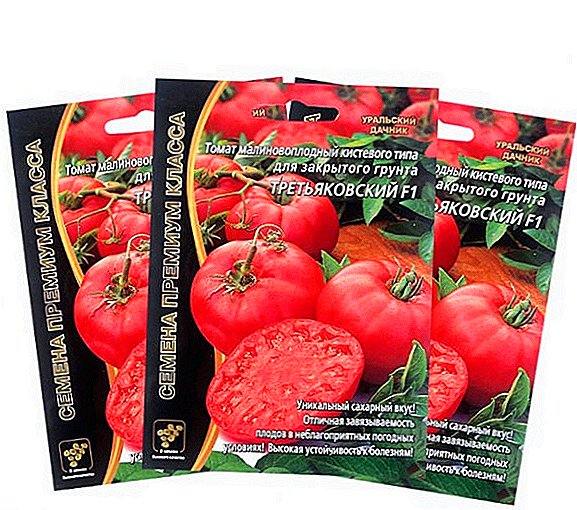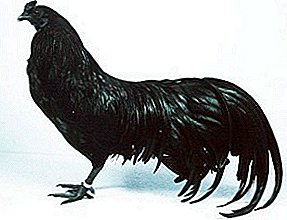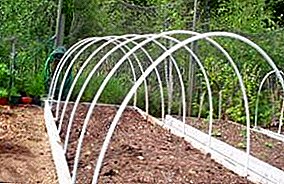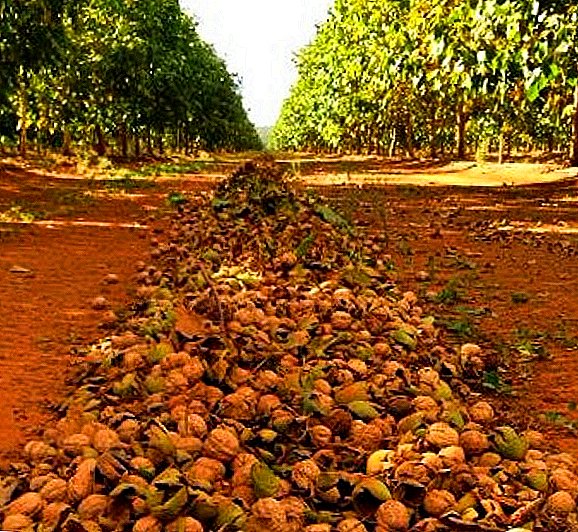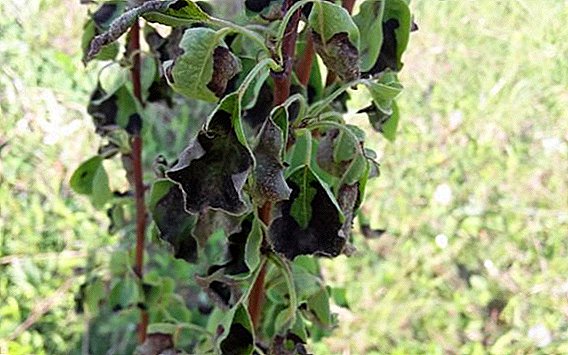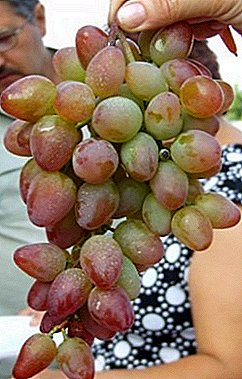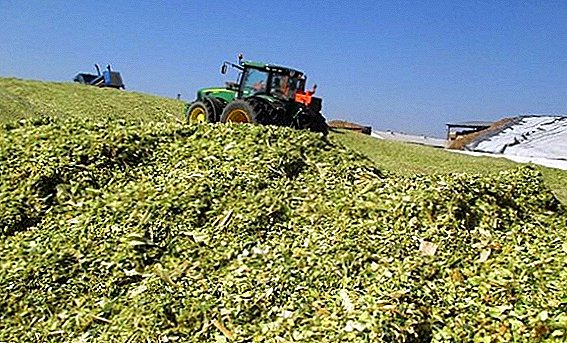 In order for the cattle to be well fed and did not drastically reduce their productivity during the winter period, it is necessary to take care of sufficient preparation of feed in advance. An important component of the diet of animals are juicy food, that is, those that contain large amounts of water. In order for them to be as nutritious and beneficial as possible, it is necessary to adhere to the technology of their preparation and storage. In this article we will talk about the preparation of the most valuable winter feed - silage.
In order for the cattle to be well fed and did not drastically reduce their productivity during the winter period, it is necessary to take care of sufficient preparation of feed in advance. An important component of the diet of animals are juicy food, that is, those that contain large amounts of water. In order for them to be as nutritious and beneficial as possible, it is necessary to adhere to the technology of their preparation and storage. In this article we will talk about the preparation of the most valuable winter feed - silage.
Did you know? In the diet of cattle, silage feed should be 50% of their total diet.
What is ensiling
In order to engage in proper preparation of silage, it is necessary to understand that this is such a juicy feed for livestock animals, which is obtained by preserving (fermenting) freshly mown or dried green parts of forage plants (tops, leaves, stalks). Nutritionally silage is similar to green fodder. Suitable for feeding all types of farm animals. Especially useful for large horned, pigs, geese, sheep, rabbits.
 The process of leaven, or ensiling, is carried out in special structures (trenches, pits, towers, etc.). There, the greens are preserved under anaerobic conditions with the help of organic acids, secreted for the most part by lactic acid fermentation. Also for the preservation can be added chemical preservatives, dietary supplements, accelerating the ensiling process.
The process of leaven, or ensiling, is carried out in special structures (trenches, pits, towers, etc.). There, the greens are preserved under anaerobic conditions with the help of organic acids, secreted for the most part by lactic acid fermentation. Also for the preservation can be added chemical preservatives, dietary supplements, accelerating the ensiling process.
Food prepared by this method is stored in a silo storage or packaged in blocks. In modern conditions, the preparation of silage is less time consuming compared to the harvesting of hay. It can be prepared in a short time, no need to pre-prepare for feeding. It does not require large investments. In addition, this method allows you to achieve less loss of nutrients. So, during ensiling, up to 10-15% of useful elements are lost, while harvesting hay - 30%.
Silage contains the amount of carotene and vitamin C that animals need, as well as water and fiber. It contributes to the better functioning of the digestive tract of livestock, contributes to the assimilation of roughage by them.
Did you know? Silage is necessary for cows, because it is a milky fodder. However, it should be fed in accordance with the recommended norms, since a large amount of it in the diet of horned cattle can lead to the fact that milk will get silage odor. Corn and cereal-bean silage are most valuable for cows.
Main silage crops
For the preparation of silage used many cultures. They are divided into three groups:
- lighter;
- difficult to comprehend;
- unbreakable in pure form.

Clover, sedge, clover, alfalfa are difficult to enslave. Tomatoes and potatoes tops, cucumbers, zucchini, melons, pumpkins, soybeans are not suitable for ensiling in pure form. Plants from the last group are harvested only in mixtures with easily fertilized or with the addition of preservatives and starters.
As a raw material for silage, tops of garden crops, cabbage leaves, mixtures of legumes and cereals, grass growing on pastures, root crops are suitable. For silage use and protein-rich food waste (pulp, bard, pulp).
Optimum mowing phase
One of the factors affecting the nutritional value of silage is the mowing season of the crop for silage. Each plant has the most favorable phase of development for use in silage feed.
So, for harvesting silage corn plants cleaned in the stage of milky-wax ripeness of grain. It is then that corn is easily ensiled and can lose only 10% of its nutritional properties when harvested. In the same phase sorghum is mown.
 The best time to collect sunflower will be the time when the plant has 30% open inflorescences. If you miss this moment, then the content of fiber in the sunflower will increase, and animals eat such food with less hunting.
The best time to collect sunflower will be the time when the plant has 30% open inflorescences. If you miss this moment, then the content of fiber in the sunflower will increase, and animals eat such food with less hunting.
Silage annual leguminous crops are harvested in the milky-waxy maturity phase of grains in the lower third, leguminous annuals - during the budding period.
The aft silage lupine is mown when the grains are formed. Clover is well ensiled during the flowering period, cereals - at the beginning of earing.
How to prepare a silo: silage preparation technology
The technology of silage preparation includes several stages:
- harvesting silage crops;
- grinding of raw materials;
- laying in storage;
- compaction of green mass;
- airtight shelter silage material.
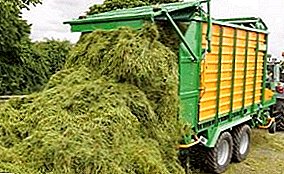 The silage mass should have an optimum humidity of 65-75%, but not higher. With excessive moisture, add chaff, chaff, chopped straw (15-20 kg / 100 kg of feed). If the moisture level is insufficient, zucchini, pumpkin, and water are introduced.
The silage mass should have an optimum humidity of 65-75%, but not higher. With excessive moisture, add chaff, chaff, chopped straw (15-20 kg / 100 kg of feed). If the moisture level is insufficient, zucchini, pumpkin, and water are introduced.- Also in the green mass must contain the necessary amount of sugars.
- The air from the raw material should be maximally forced out by good compaction.
- The tank, pit, trench or room where the silo was laid should be hermetically sealed to prevent oxygen and water from entering it.
After harvesting plants for ensiling, they must be crushed. The average length of chopped herbs should be 3-4 cm.
Important! The lower the humidity of the silage raw material, the more thoroughly it must be ground (2-3 cm). And vice versa - with a high degree of humidity (80% and above), a larger cutting of green mass (8-10 cm) is needed.To determine the degree of humidity, you need to twist a few plants in a bundle. At the same time, juice stands out at the bends - this means that the humidity level is normal. If the greens are not wet enough, its foliage will be soft, and when curled, the liquid will not flow out. With excessive moisture, the juice from the plants is released even without twisting, just during transport.
 To lay the silo, it is necessary to dig a hole about 2 m deep. The width and length of the recess do not matter. It may even be round. The walls of the pit should expand upwards. They need to be smeared with clay. The bottom can be covered with fallen leaves or straw.
To lay the silo, it is necessary to dig a hole about 2 m deep. The width and length of the recess do not matter. It may even be round. The walls of the pit should expand upwards. They need to be smeared with clay. The bottom can be covered with fallen leaves or straw.
Next, in a hole in layers of 20-25 cm stack green mass, tightly tamping it, especially near the walls. (Layers of green mass can be alternated with layers of chopped straw 40-50 cm in height.) Every day the mass is filled to 80-100 cm.
The recess is filled with the top - within a few days its contents will settle. The denser the tab, the better the silage will be. At the same time, herbs with normal humidity are tamped as best as possible, and with high humidity they are subjected to moderate tamping. The temperature inside the mass should not exceed 38 degrees.
Important! Good silage can be prepared only for three to four days. When laying the pit more than this period, the feed warms up, loses protein and carotene.After a full load, the pit is immediately covered with plastic wrap and covered with a 25-30 cm layer of soil or peat. You can also cover with bales of compressed straw. In the absence of films, a 30-centimeter layer of wet straw, a 5-centimeter layer of clay and a 20-25-centimeter layer of soil are poured. To protect the silo from precipitation, a canopy is installed above the pit, and grooves are pulled out around it to prevent water from entering around it.
With proper ensiling, the feed will be ready for feeding in 1-1.5 months. Slow-growing plants can be used earlier - in 15-20 days. The legume silo will need 1.5-2 months for the starter.
There is a way to do without the construction of buildings and shelters. You can use the method of silage in polymer hoses. In this case, the preservation process begins immediately after laying the green mass in the sleeve. Losses with this method range from 3 to 5%. High-quality feed can be removed from the sleeve as needed throughout the year.
When harvesting a small amount of feed, you can use a barrel.
Silo storage
 The surface of the stored silo should be flat and smooth. The main conditions for proper preservation will be the maintenance of the required temperature and integrity of the encapsulation.
The surface of the stored silo should be flat and smooth. The main conditions for proper preservation will be the maintenance of the required temperature and integrity of the encapsulation.
To take the required amount of feed, the covering materials slightly raise. The open surface should be as small as possible. Then the pit is again covered with foil and sprinkled with straw or earth.
After being removed from the silo store, the feed is only suitable for one feeding, since it quickly loses its nutrients in the air.
When the whole silo will be used, the pit will need to be cleaned of residues and treated with a solution of freshlylive lime.
Silos and preservatives
In order to preserve the largest possible amount of nutrients, when preparing silage resorted to the use of chemical preservatives. This method is used for ensiling sluggish and non-silage crops or green mass with a high degree of moisture. The effect of preservatives is determined by their ability to regulate the vital activity of microorganisms: the development of putrefactive, mold - suppress, lactic acid and yeast - limit.
Did you know? The introduction of chemicals into corn silage helps to preserve up to 90% of sugars in it.The addition of preservatives makes it possible to produce high-quality silage from any raw material (including one that is difficult to ensiling), regardless of its moisture level and growing conditions. Additives saturate the feed with nitrogen, phosphorus, sulfur, microelements.
 To date, the choice of preservatives for the preparation of silage is huge - about 2.5 thousand chemical compounds have been developed. Pyrosulphite and sodium bisulfite, ammonium pyrosulphate and ammonium dihydrosulphate, formalin and others have good preservative properties. They sprayed silage mass. When choosing an additive, preference should be given to those that do not contain poisons and carcinogens.
To date, the choice of preservatives for the preparation of silage is huge - about 2.5 thousand chemical compounds have been developed. Pyrosulphite and sodium bisulfite, ammonium pyrosulphate and ammonium dihydrosulphate, formalin and others have good preservative properties. They sprayed silage mass. When choosing an additive, preference should be given to those that do not contain poisons and carcinogens.
Also, when laying the silage, mineral acids (formic, sorbic, lactic, propionic, acetic) are introduced or their mixture with salts. They are made in several layers in 20-25 cm.
When ensiling grass, corn with legumes, you can add a special starter, containing lactic acid bacteria.
Thus, the quality of the silo will depend on several factors: the type of plants used, the phase of their harvesting, their moisture, the density of laying and sealing the silo. High-quality food can be identified by color - it will be from yellow-green to dark brown, and a pleasant smell - sauerkraut, pickled apples, baked bread (depending on the composition). If the silo has a different flavor, for example, manure or ammonia, its use is unacceptable.


 The silage mass should have an optimum humidity of 65-75%, but not higher. With excessive moisture, add chaff, chaff, chopped straw (15-20 kg / 100 kg of feed). If the moisture level is insufficient, zucchini, pumpkin, and water are introduced.
The silage mass should have an optimum humidity of 65-75%, but not higher. With excessive moisture, add chaff, chaff, chopped straw (15-20 kg / 100 kg of feed). If the moisture level is insufficient, zucchini, pumpkin, and water are introduced.